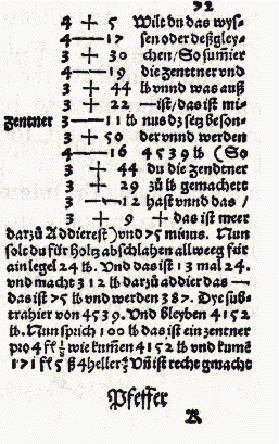Skip over navigation
Article by NRICH team
Where did they come from? (or 'cutting a long story short')
A symbol is a simple shape or simple picture that stands for a more complicated idea. Mathematicians like to use symbols because, with just a few squiggles and shapes, they can tell a rather long mathematical story.
For example: 64 people arrived on time and sat down in the theatre. 23 more people came in late and 5 people left just after the play started. If we combine the 64 and the 23 we get 87 people. Take off the 5 that left and that leaves 82 people still watching the play .
If we use symbols this could be just written as

Someone, often long ago, invented these symbols and other people started using them. The plus sign + seems to have started as a quick way of writing the Latin word et, which means 'and' as long ago as the year 1417.
Here is a picture of some of the earliest uses of plus + and minus - symbols in a printed book (1526).
It is thought the equal sign = was invented by Robert Recorde. In 1557, "I will sette as I doe often in woorke use, a paire of parralles, or Gemowe lines of one lengthe, thus ==, bicause noe 2 thynges can be moare equalle."



Or search by topic
Number and algebra
Geometry and measure
Probability and statistics
Working mathematically
Advanced mathematics
For younger learners
Age 5 to 14
Published 2011
Mathematical Symbols
Where did they come from? (or 'cutting a long story short')
A symbol is a simple shape or simple picture that stands for a more complicated idea. Mathematicians like to use symbols because, with just a few squiggles and shapes, they can tell a rather long mathematical story.
For example: 64 people arrived on time and sat down in the theatre. 23 more people came in late and 5 people left just after the play started. If we combine the 64 and the 23 we get 87 people. Take off the 5 that left and that leaves 82 people still watching the play .
If we use symbols this could be just written as
64 + 23 - 5 = 87 - 5 = 82

Someone, often long ago, invented these symbols and other people started using them. The plus sign + seems to have started as a quick way of writing the Latin word et, which means 'and' as long ago as the year 1417.
Here is a picture of some of the earliest uses of plus + and minus - symbols in a printed book (1526).
It is thought the equal sign = was invented by Robert Recorde. In 1557, "I will sette as I doe often in woorke use, a paire of parralles, or Gemowe lines of one lengthe, thus ==, bicause noe 2 thynges can be moare equalle."
You may also like
Prompt Cards
These two group activities use mathematical reasoning - one is numerical, one geometric.
Consecutive Numbers
An investigation involving adding and subtracting sets of consecutive numbers. Lots to find out, lots to explore.
Exploring Wild & Wonderful Number Patterns
EWWNP means Exploring Wild and Wonderful Number Patterns Created by Yourself! Investigate what happens if we create number patterns using some simple rules.

